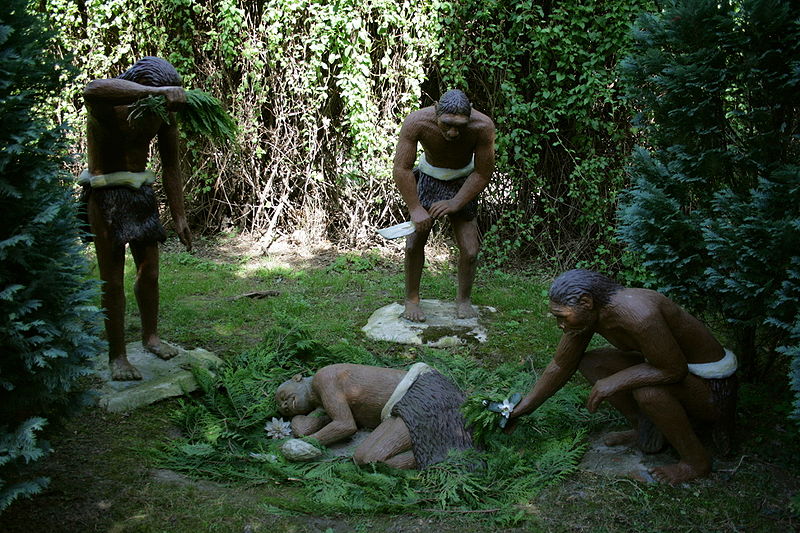As children, most of us picture Neanderthals as the archetypal caveman even though Neanderthals are the most recent archaic humans to Homo sapiens. First emerging between 300,000 and 100,000 years ago, Neanderthals lived in a landscape filled with limestone caves. Because limestone is an excellent preserver of bones, we know more about Neanderthals than any other archaic human group.1 Archaeologists have been studying Neanderthal sites since the mid-1850s. We know how they lived, what they ate, how they hunted, the tools they used and how those tools changed over time, and what they wore.2 We even know that they buried their dead. Or did they? Archaeologists have been studying this possibility for over one-hundred years and still cannot seem to agree on the matter.
The controversy over Neanderthal burial of the dead began with the discovery of a body in a cave in La Chapelle-aux-Saints in southwest France, originally found in 1908. It was the first intact body found buried in the limestone caves frequently used by the Neanderthals as homes. A debate quickly arose among archaeologists to determine if the body had been buried or if it was simply an ancient body dump. A private team was hired to reexamine the evidence from the original excavation and they found the burial to be authentic because the body was not in a natural formation but had, in fact, been placed in a grave dug by human tools.3 Re-excavation of the cave revealed more Neanderthal bones and teeth, tools, and animal remains. Scientists were able to conclude that since the animal bones found in the cave showed signs of scavenger activity and the buried body did not, the body must have been buried quickly after death to have prevented normal scavenger activity. They also found no weathering on the Neanderthal bones from the burial site, but they did find weathering on the animal bones found loose in the cave, further implying that the body had been buried soon after death.4
The Shanidar Cave in the Kurdistan area of northern Iraq is a Neanderthal cave where eight adults and two infants were found buried in a grouping of graves. The Shanidar skeletons and grave sites have been well studied by archaeologists who have made several assumptions about Neanderthals based on the findings. One of the graves contained pollen from flowers that could only have come from a mountain range near the Shanidar Cave. Archaeologists believe that this is evidence that the body was either buried with flowers or the flowers were placed upon the grave after the burial, much like modern humans do at funerals. Another one of the Shanidar skeletons shows extensive injuries that had healed before death. This demonstrates that not only did the Neanderthal have some basic first aid skills, but they took care of their sick and injured. Archaeologists claim that this is suggestive of the Neanderthals possessing a complex social society.5
Excavations at the La Ferrassie location began over one-hundred years ago and have revealed seven Neanderthal skeletons, of which five are children. Examination of the burial sites at La Ferrassie demonstrate that all of the bodies were deliberately buried.6 Archaeologists have also revealed that the bodies were all found in what appears to be a cemetery type layout, with all the bodies oriented with their head facing east and feet facing west. The adult male, the most complete Neanderthal skeleton to date, shows that he was buried in a shallow grave in a fetal position with three rocks placed on his head. He also had flint tools and pieces of animal bones in his grave. The adult female was also in a fetal position, possibly tied with ropes, and placed in a small grave. The children were all buried with scrapers and pointed tools.7

At the Le Moustier site, several graves have been found, all of them shallow with the body in a fetal position. One particular grave contains the body of a young Neanderthal boy buried with flints under his head as if a pillow, an ax in his hand, an ox skull near his head, and cattle bones spread around him. What made this unusual was the finding that some of the cattle bones had been charred. Scientists have wondered if the charred bones were a sign of a funeral feast or provisions for the afterlife, both of which indicate that Neanderthals had a more complex social system than originally believed.8

Other burials in the area occupied by Neanderthals show similar attributes. In Uzbekistan, at Teshik Tash, a young Neanderthal boy was found buried with forty goat horns circling his body, points driven into the ground. At Saint-Cesaire, a Neanderthal adult was found buried with stone tools, some in his hands as if being used. A burial in Spy shows evidence of a fire on the top of the grave site, although archaeologists are not sure the intent of the fire. Mounting evidence shows that Neanderthals buried their dead much like other ancient cultures.9 Nothing demonstrates this more than the finding at Des-Cubierta Cave.
The Des-Cubierta Cave, north of Madrid, holds what archaeologists say is the first firm evidence of Neanderthal funerals. A series of small fires has been discovered surrounding a burial site of a young child known as Lozoya Child. All that has been found of the toddler is a jaw bone and six teeth that date back approximately 38,000 to 42,000 years ago. The child was buried with stone tools as well. Archaeologists found in each fire a horn or antler from local herbivores, aurochs, bison, and red deer to be exact. There was also a rhinoceros skull nearby.10
When examining the evidence gathered from the Lozoya Child and found at Des-Cubierta Cave, anthropologists have come to the conclusion that the cave was used as a specific place to mourn and remember the dead. They argue that the position of the bones and the stone tools found with the body, indicate it was not a random placement nor that cave was a dwelling and the tools just happened to be where the body landed. Anthropologists believe the layout of the cave, the location of the approximately 30 fires with horns or antlers, and the placement of the skull, all have the appearance of a place where rituals took place, or at the very least the cave held symbolic significance to the Neanderthal in the area.11 Archaeologists had found some caves with bones and antlers in Israel and Syria, but nothing as elaborate as the cave at Des-Cubierta.
A good archaeologist knows that when excavating old sites, it is always difficult to determine if the items found in a grave were put there on purpose or if they fell in by accident. It is even possible that the items just happened to be laying on the ground when the body was put there. Some archaeologists argue that Neanderthal burials and funerals are just a modern interpretation of what happened, a desire to place our belief system on an archaic human.12 In the case of the fire at the Spy burial, it could just simply be a fire that was built on top of a long forgotten grave. The pollen at the Shanidar grave could have been there long before the body was placed there. Or it is possible it was from flowers placed there to mask the odor of decaying bodies?
An example of this can be found at Rod de Marsal where a complete skeleton of a Neanderthal child was excavated in 1961. This burial was long used to support the argument in favor of Neanderthals burying their dead; however, modern archaeology tools and techniques have changed that idea. It is now widely accepted that the child simply fell through a crevice into a natural pit from above along with the tools found near him.13 Some archaeologists would argue that if we are wrong about one burial, how many others have we gotten wrong over the last century?
The reason so much emphasis is placed on Neanderthal burials is not so much to determine if they buried their dead or even how they buried them. Today scientists commonly accept that Neanderthals did bury their dead otherwise the number of graves would be much smaller.14 If Neanderthals simply wanted to dispose of the dead away from the campsite, they could have just carried them off a distance or thrown them into a ravine, problem solved. But we know that they buried their dead; that is not any longer the question to ask. What does matter is why they buried them.15

We know that Neanderthals lived in social groupings and they decorated their bodies and used complex tools that changed over time. All of this is proof that Neanderthals had social and cultural traditions.16 Burials are considered a key feature of human behavior, but funerals are considered a feature of the belief in an afterlife. If Neanderthals actually had funerals for their people, then there is an assumption that they did this for one of two reasons: to remember their departed loved one as we do today, or to leave the body with the items it needed to pass into the afterlife. In either case, a funeral is a symbolic act and if Neanderthals were holding funerals, they are more complex and have a higher society than scientists had believed.17
- Britannica School, January 2015, s.v. “Neanderthal,” by Erik Trinkaus and Russel Howard Tuttle. ↵
- Britannica School, January 2015, s.v. “Neanderthal,” by Erik Trinkaus and Russel Howard Tuttle. ↵
- Zach Zorich, “Did Neanderthals Bury Their Dead?” Archaeology 67, no. 2 (March/April 2014): 19. ↵
- Kate Wong, “Ancient Burial,” Scientific American 310, no. 3 (March 2014): 19. ↵
- Owen Edwards, “The Skeletons of Shanidar Cave,” Smithsonian Magazine 38, no. 6 (March 2010): 18. ↵
- Michael Balter, “Did Neanderthals Truly Bury Their Dead?” Science 337, no. 6101, (September 2012): 1443-1444. ↵
- Paul Jordan, Neanderthal (United Kingdom: Sutton, 1999), 102-106. ↵
- Paul Jordan, Neanderthal (United Kingdom: Sutton, 1999), 100. ↵
- Paul Jordan, Neanderthal (United Kingdom: Sutton, 1999), 97-102. ↵
- Richard Gray, “First Known Neanderthal Burial Rituals,” New Scientist 232, no. 3093, (October 2016): 14. ↵
- Richard Gray, “First Known Neanderthal Burial Rituals,” New Scientist 232, no. 3093, (October 2016): 14. ↵
- Michael Balter, “Did Neanderthals Truly Bury Their Dead?” Science 337, no. 6101, (September 2012): 1443-1444. ↵
- Michael Balter, “Did Neanderthals Truly Bury Their Dead?” Science 337, no. 6101, (September 2012): 1443-1444. ↵
- Michael Balter, “Did Neanderthals Truly Bury Their Dead?” Science 337, no. 6101, (September 2012): 1443-1444. ↵
- Michael Balter, “Did Neanderthals Truly Bury Their Dead?” Science 337, no. 6101, (September 2012): 1443-1444. ↵
- Paul Jordan, Neanderthal (United Kingdom: Sutton, 1999), 100. ↵
- Michael Balter, “Did Neanderthals Truly Bury Their Dead?” Science 337, no. 6101, (September 2012): 1443-1444. ↵



36 comments
Brandon Vasquez
This article was amazing! The term “caveman” and “Neanderthals” always meant the same thing to me growing up and even before reading this article. Attempting to understand how these people lived is difficult but it allows us to not only understand how they lived during their times but also what ideas of theirs were passed along for generations such as the burials.
Jourdan Carrera
Neanderthals have always and always will fascinate me. They are a species which lived alongside us and may have even interbred with us because of this I find this article about them possibly having burial rights and a belief in the afterlife to be extremely fascinating. Along with that I do, personally believe that they did have some belief in an afterlife and were much more complex than previously thought.
Sara Guerrero
Reading this article I think that these Homo Sapiens in the Netherlands were advanced enough mentally to show emotion and marked the beginning of burials and funerals. Since they have evolved from surviving by oneself to creating a community where everyone has a crucial role for the community to survive they must have had a way to communicate and convey emotion. It’s definitely very interesting to read the debate of these burials and if it was just a body dump or an actual meaningful burial.
Glory Turnbull
I think this article really illuminates how important it is to questions the assumptions made in our field of study. Just because we badly want something to be true doesn’t mean that it will be– confirmation bias is always an issue. I’m really fascinated by pre-human bipeds, as they interacted with early humans, and could have easily become the dominant species.
Nicholas Robitille
It is quite interesting to see that this society actually has major practices like burial, because generally, these people are seen mostly as roaming barbarians. If these people had burial practices, it is much easier to see where our burial practices may have originated from. I see this as very significant, as well, because if these supposed burial rituals can be believed, then it would not be very much of a stretch for them to have different or more complicated undiscovered social norms. This discovery has a large amount of potential for study.
Michael Lazcano
To see that this species that so closely resembled us, and is even in our DNA was able to have burial rituals is fascinating. I have always heard that they weren’t the most intelligent creature, but they acted similarly to us in the way they actually cared for their own. This also brings into debate If they had a belief system or some sort of God that they worshipped, because generally a ritual for burial indicates some sort of belief in an afterlife. While we we can never know for sure, it will always be an interesting question to ponder til we go to our graves.
Mauro Bustamante
The Neanderthals definitely deserve to have many of those stereotypes of them being “archetypal caveman” corrected.This article was well written and very informative, I wondered if they had rituals and ceremonies to celebrate weddings or birth dates. I now know they had respect for life and celebrated it by burying their dead, they honored them by providing them a resting place.. I always thought that caveman are beings with animalistic instincts and that they would just leave the dead behind and let nature does its work.
Raul Vallejo
Whenever I thought about Neanderthals I thought of them to be extremely primal and very savage beings. I never in a thousand years would have expected them to do things within their cultures and communities that are somewhat similar to the traditions that we have now thousands of years after civilizations have evolved and adapted. This was a very interesting read.
Amelia Hew
It surprises me on how advance the Neanderthals are during the time period. I always thought that caveman are beings with animalistic instincts and that they would just leave the dead behind and let nature does its work but the article shows that the Neanderthals somehow has knowledge of the afterlife and perhaps even mourned those who had passed on. This is truly a fascinating article that opened my eyes to a whole new world.
Michael Hinojosa
After reading this article I’m definitely going to have to give the “neanderthals” more credit than they’re due. The media always depicts them as nothing more than unintelligent savages and the fact that their very name is an insult is even more proof that we as people have only seen them as such. But to know that they had their own unique burial ceremonies proves that they’re more intelligent than we think, and it personally makes me wanna know the extent of their intelligence!